Libya: The fall of Gaddafi
Col Muammar Gaddafi has been killed after months of fighting in a violent uprising against the former leader's 42-year rule. With audio commentary by Middle East editor Jeremy Bowen, explore the chapters below to find out how the crisis unfolded.
Violent protests 16 - 23 February
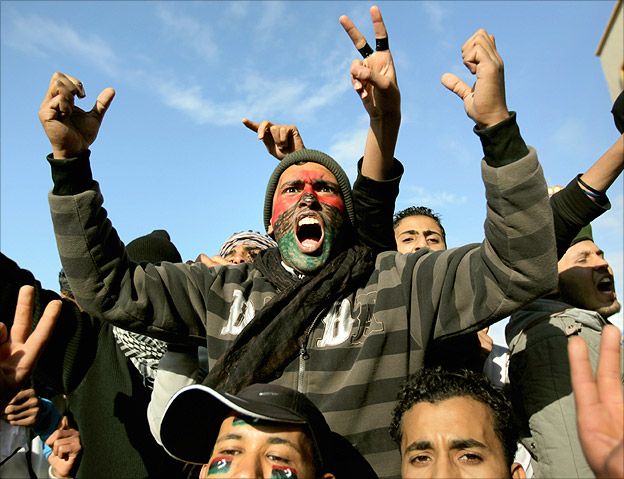
Hundreds have lost their lives in the bitter conflict that has been raging in Libya for almost five months.
It began with protests against Col Muammar Gaddafi's regime and has escalated into a bloody battle for territory between government and rebel forces in the west and east of the oil-rich country.
The uprising, inspired by events in neighbouring Tunisia and Egypt and sparked by the arrest of a Libyan human rights campaigner, began in February. Many were killed as authorities tried to suppress the revolt.
Some of the biggest demonstrations were seen in the eastern port of Benghazi - the centre of unrest.
Thousands of foreigners tried to flee Libya, with several countries evacuating citizens.
Rebel advance, Gaddafi retaliation 24 Feb - 6 March
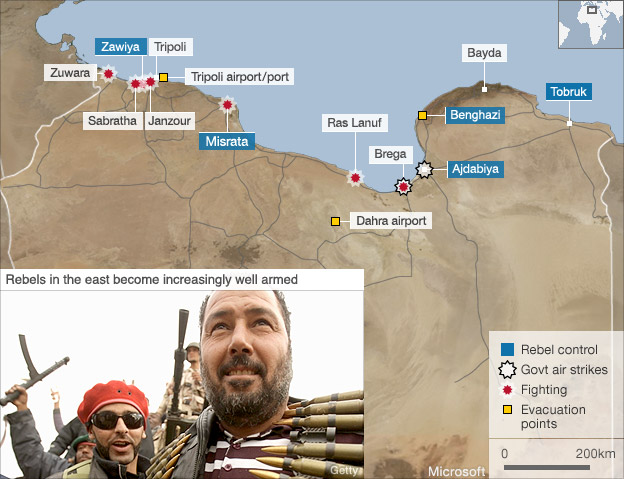
Rebels began to organise from their Benghazi base and towns in the west fell to their forces for the first time. Government troops retaliated with ground assaults and bombing raids. In the capital, anti-government protesters came under gunfire from pro-Gaddafi troops.
As the international community condemned the attacks on civilians, an operation to evacuate hundreds of thousands of foreign nationals was launched.
But Col Gaddafi continued to tighten his grip and mounted further attacks on rebel-held cities to the west and east. Battles raged in Brega, Ras Lanuf and Bin Jawad, but rebels succeeded in taking Ras Lanuf. Zawiya and Misrata in the west also saw heavy fighting.
Col Gaddafi gave a rambling yet defiant televised speech, saying he would "fight until the last man".
Crisis escalates 7 - 18 March
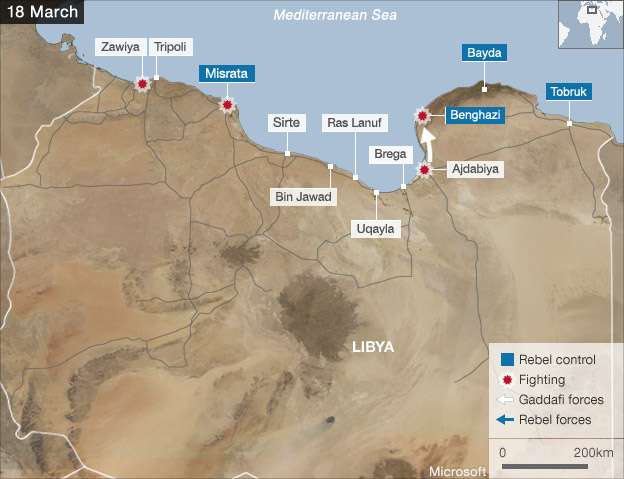
Pro-Gaddafi forces retook the oil towns of Bin Jawad, Ras Lanuf and Brega. Using air strikes and helicopter gunships, they pushed rebels back along the coast.
Fierce fighting later took place in Ajdabiya and loyalists launched bombing raids on the rebel stronghold of Benghazi. Rebels deployed tanks, artillery and helicopters to repel the assault.
In western Libya, battles raged for days in Misrata and Zawiya, with the latter coming under control of government forces. A source in Zawiya said bullets had been flying in all directions and that women and children as young as five were among the dead. The government denied its troops were killing civilians.
As the crisis grew, the UN Security Council backed a no-fly zone over Libya in order to protect civilians.
As attack plans were drawn up under a UN resolution, Col Gaddafi's government declared a unilateral ceasefire, but his forces continued fighting.
Coalition bombing begins 19 - 20 March
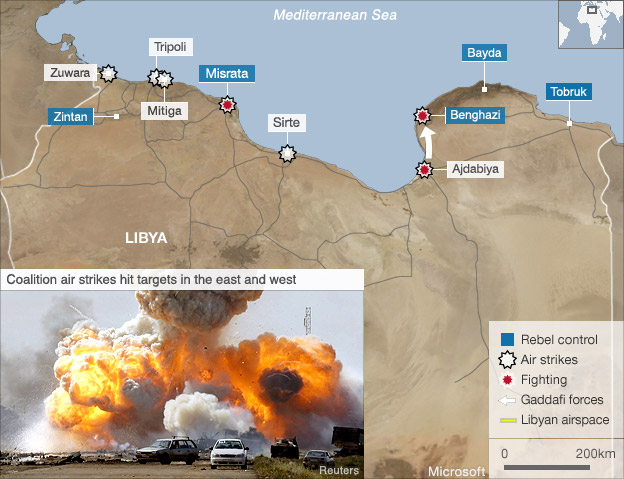
The coalition launched air strikes against Libyan targets after government forces, despite having called a ceasefire 24 hours earlier, began a fierce attack on the eastern rebel-held city of Benghazi.
French aircraft fired the first shots, attacking an armoured convoy west of Benghazi. French President Nicolas Sarkozy announced "all necessary means" would be used to prevent further civilian deaths.
France, the US and the UK took part in the early missions. US commanders said the strikes had succeeded in crippling Gaddafi's air capability to allow the effective enforcement of the no-fly zone.
The strikes also appeared to have halted the advance of the Libyan leader's forces on Benghazi. But Col Gaddafi remained defiant. "We promise you a long, drawn-out war with no limits," he said in a phone call to Libyan state TV. "We will fight inch by inch."
Advance and retreat 21 March - 15 April
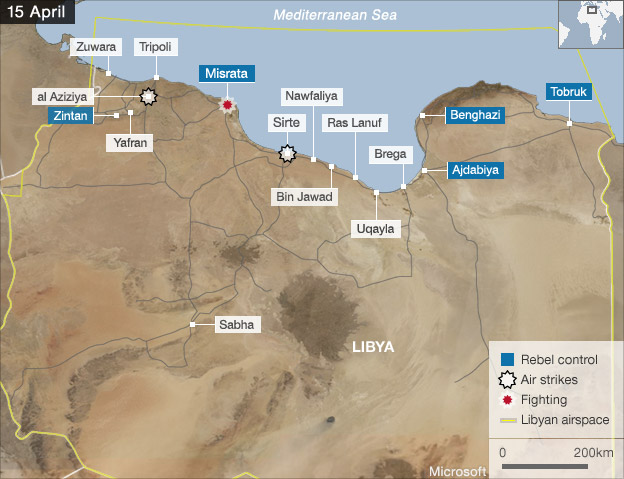
As coalition bombing missions continued, forces loyal to Col Gaddafi were forced to pull back from the rebel stronghold of Benghazi along the eastern coast.
The rebels went on to recapture the key coastal towns of Ajdabiya, Brega, Uqayla, Ras Lanuf and Bin Jawad. But rebels were later forced to retreat east of Brega.
Over the coming days, rival forces battled for control of Brega. Coalition planes mistakenly hit a rebel position forcing them to retreat beyond Ajdabiya.
Elsewhere, coalition air strikes hit key Libyan military targets including positions in Misrata, Sirte, Brega, Ajdabiya and Tripoli, where Col Gaddafi's al Aziziya compound was bombed. Nato took command of coalition operations.
Fighting continued in the western towns of Zintan and Yafran and the situation in the besieged city of Misrata deteriorated. Aid agencies said the humanitarian situation had become critical.
Battle for Misrata 16 - 25 April
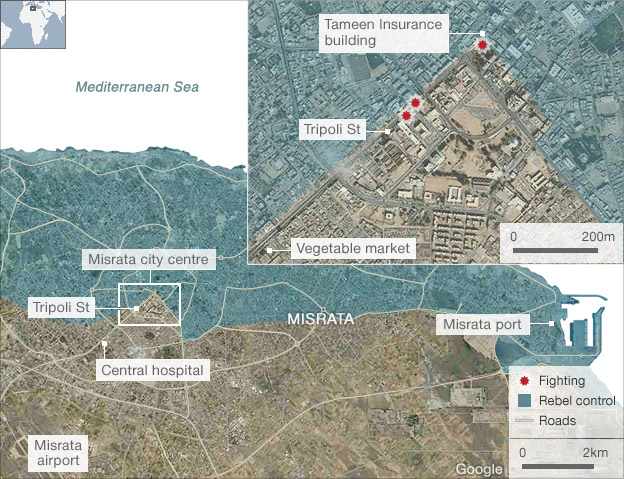
As battles raged in the east, the rebel-held western cities of Misrata and Zintan continued to come under rocket attack from Col Gaddafi's forces.
The intense shelling of Misrata became the focus of international concern, and boats began evacuating thousands of migrant workers trapped in the city.
As the UN moved food supplies into western Libya through a humanitarian corridor, the BBC saw evidence that cluster bombs were being used by pro-Gaddafi forces, a charge they denied.
The street battles led Nato countries to offer military advice and equipment to aid the rebel forces. Meanwhile, a Nato air strike badly damaged buildings in Col Gaddafi's Bab al-Aziziya compound in Tripoli.
Stalemate 26 April - 12 August
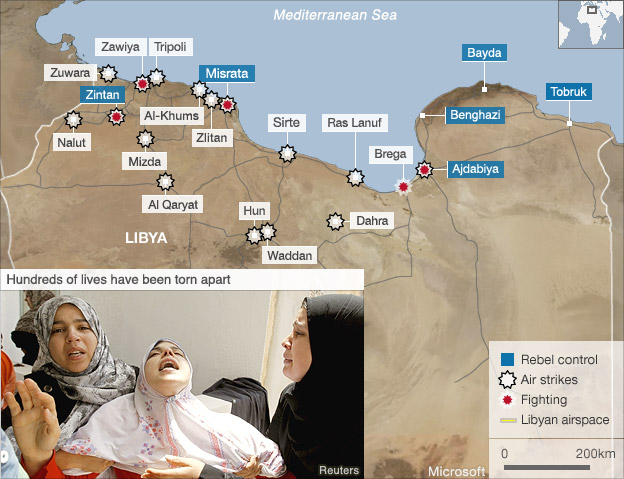
Nato repeatedly hit Tripoli and other targets. Missiles hit Col Gaddafi's compound, with one attack killing one of his sons and three grandchildren.
The International Criminal Court sought the arrest of the Libyan leader, his son and intelligence chief for crimes against humanity. The rebels were later recognised by some Western nations as the legitimate government.
On the ground, rebels pushed government troops back from Misrata, but fighting continued in the east and west. In August, the Libyan government accused Nato of killing 85 civilians in an air strike near Zlitan, west of Misrata. Nato insisted it hit a military staging base.
But, with Nato air power not ensuring rebel victory, many believed the country had reached stalemate.
Endgame 13 August - 20 October
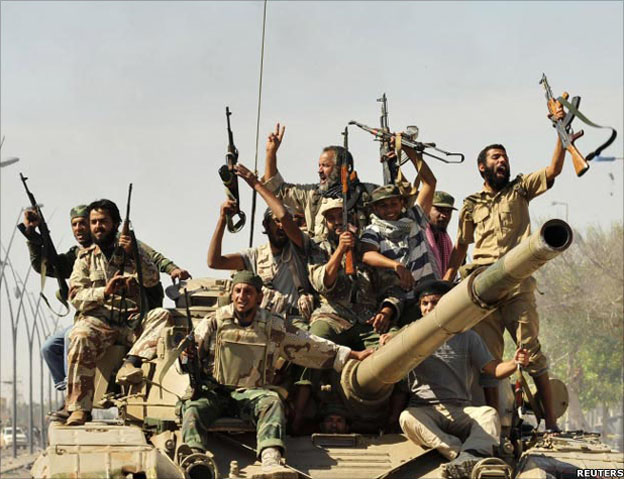
After months of little progress, a major offensive by the rebels saw them push out from the west towards the towns of the coastal plain, breaking the deadlock. They took control of a series of strategic towns before capturing Tripoli.
The rebels' National Transitional Council - now recognised as the country's interim government - went on to make a failed attempt to negotiate a peaceful resolution to stand-offs in the remaining places controlled by loyalists.
As fighting continued, anti-Gaddafi forces went on to take the key southern town of Sabha and moved in on the remaining two loyalist strongholds, Bani Walid - south-east of Tripoli - and the fugitive leader's birthplace of Sirte.
NTC forces claimed victory in Bani Walid mid-October and Sirte fell some days later. Col Gaddafi's death was reported by the NTC shortly after.
~RS~q~RS~~RS~z~RS~34~RS~)









 Life under IS in Sirte
Life under IS in Sirte Nigeria rivals sign peace accord
Nigeria rivals sign peace accord